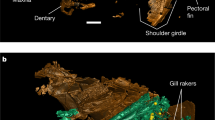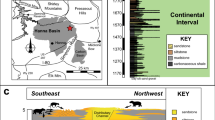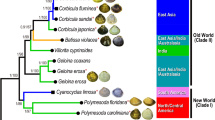Abstract
Berry and Barker1 have suggested that laminae, ridges and troughs, and bands on present day and Cretaceous bivalve shells, are growth increments of the day, month and year, respectively. By counting the number of laminae in a number of ridges and troughs they therefore find that the number of days in the month in the Late Cretaceous was 29.65±0.18 (S.D.). They also count in specimens of Idonearcus vulgaris of Late Cretaceous age 24.98±0.04 (S.D.) half-monthly clusters in annual bands or 12.49±0.02 months in the year. Multiplying these two results, they find 370.3 days in the year in the Late Cretaceous. Wells2 had proposed that such observations on palaeontological clocks should be compared with a plot of the length of the day through geological time obtained by the extrapolation of the astronomically determined secular lengthening of the day since the seventeenth century. Because this value (2 ms/century) leads to a value of 371 days in the year in the late Cretaceous, Berry and Barker find their results highly satisfactory.
This is a preview of subscription content, access via your institution
Access options
Subscribe to this journal
Receive 51 print issues and online access
$199.00 per year
only $3.90 per issue
Buy this article
- Purchase on SpringerLink
- Instant access to full article PDF
Prices may be subject to local taxes which are calculated during checkout
Similar content being viewed by others
References
Berry, W. B. N., and Barker, R. M., Nature, 217, 938 (1968).
Wells, J. W., Nature, 197, 948 (1963).
Scrutton, C. T., Palaeontology, 7, 552 (1964).
Runcorn, S. K., Nature, 204, 823 (1964).
Runcorn, S. K., Mantles of the Earth and Terrestrial Planets, 225 (John Wiley, 1967).
Author information
Authors and Affiliations
Rights and permissions
About this article
Cite this article
RUNCORN, S. Fossil Bivalve Shells and the Length of Month and Year in the Cretaceous. Nature 218, 459 (1968). https://doi.org/10.1038/218459a0
Received:
Published:
Issue date:
DOI: https://doi.org/10.1038/218459a0
This article is cited by
-
Stable Isotopes Reveal Rapid Enamel Elongation (Amelogenesis) Rates for the Early Cretaceous Iguanodontian Dinosaur Lanzhousaurus magnidens
Scientific Reports (2017)
-
The moon as the origin of the Earth's continents
The Moon and the Planets (1980)
-
Evolution of the Moon's orbit and the origin of life
Nature (1974)
-
Paleontological evidence on the Earth's rotational history since early precambrian
Astrophysics and Space Science (1972)
-
Three Origins of the Moon
Nature (1969)



